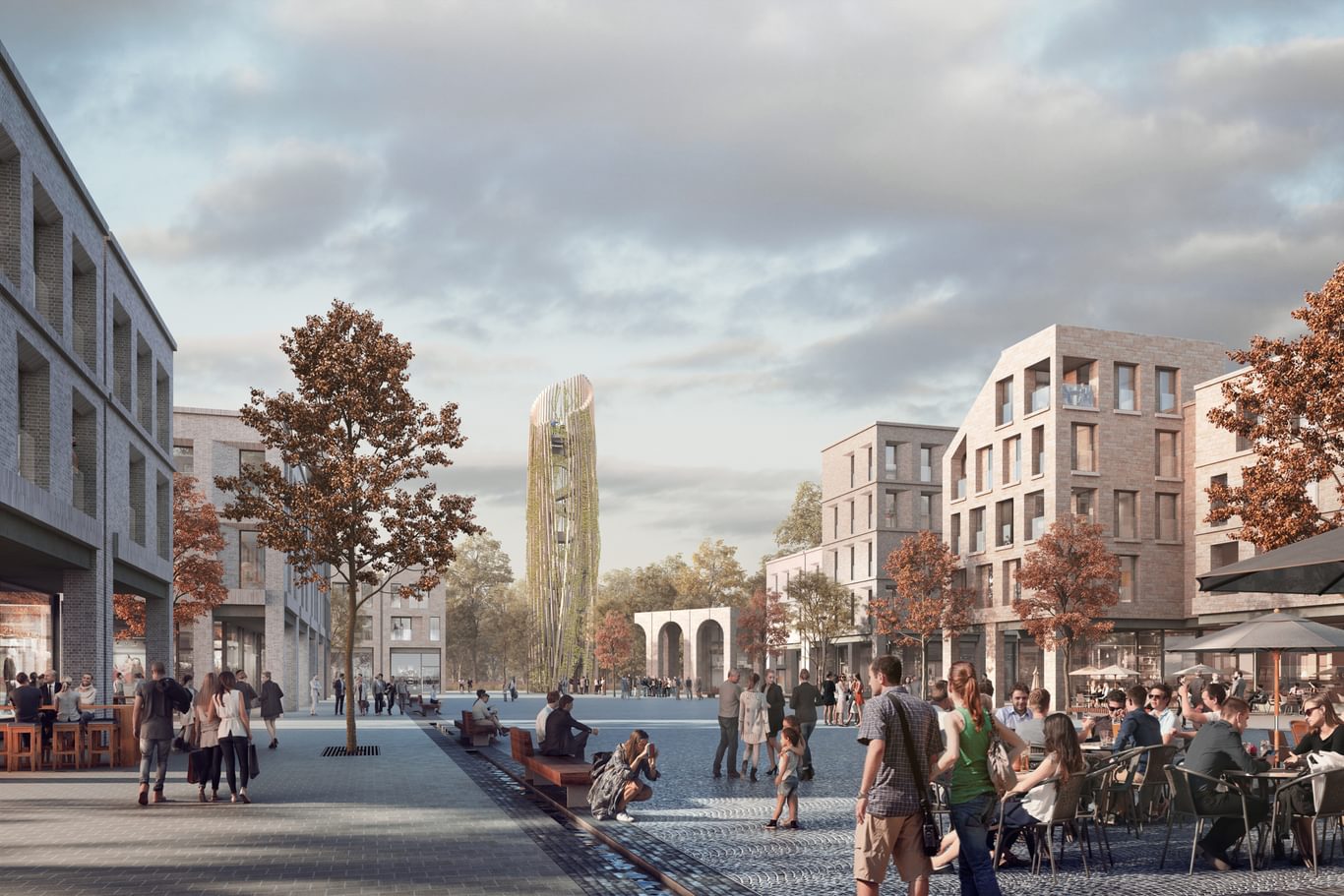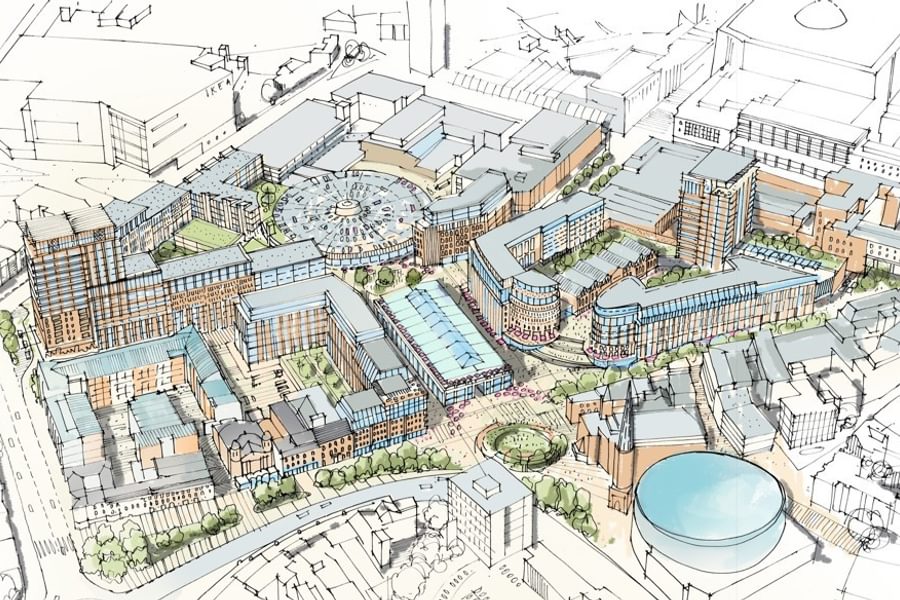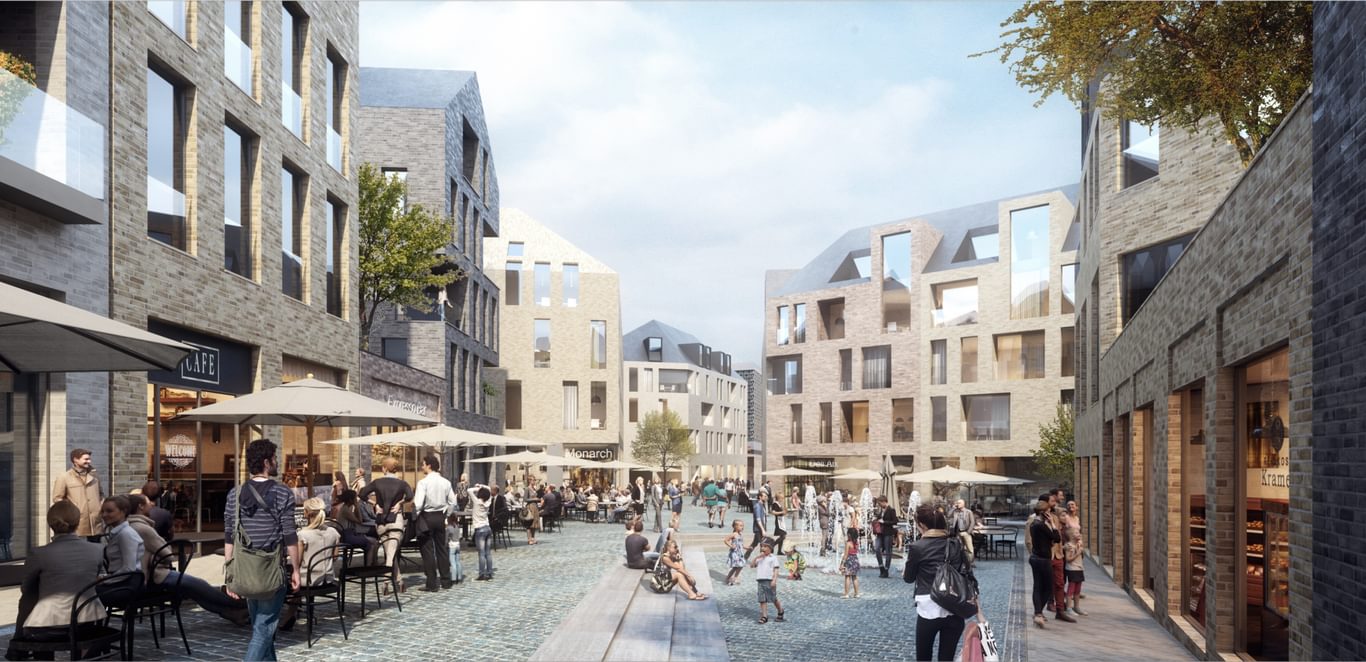
Delivering successful local centres and neighbourhoods
Introduction
Local centres sit at the heart of our communities, serving as the social and cultural anchors that sustain vibrant neighbourhoods. Their importance was emphatically underscored during the Covid-19 pandemic, which reestablished the vital role these centres play in daily life. Local centres are more than just a collection of buildings; they help create sustainable communities, offering a space that is easily accessible to all and fosters interaction, belonging, and inclusivity.
Local centres sit at the heart of our communities, serving as the social and cultural anchors that sustain vibrant neighbourhoods.
A successful local centre provides a dynamic mix of uses tailored to its community, serving as a hub for retail, leisure, health, education, and community services. These centres must respond to their unique local culture and context, reflecting the diversity of their surrounding population while promoting environmental sustainability and economic resilience. In the UK, where urban centres range from historic villages to modern housing developments, ensuring their relevance and adaptability is key to their success.
Recent data highlights that residents who live within walking distance of thriving local centres report higher levels of satisfaction and well-being, demonstrating the intrinsic value of these spaces in creating cohesive and resilient communities. For planners, developers, and policymakers, the challenge lies in delivering new centres and reinvigorating existing ones to meet modern needs while preserving their local character.
A successful local centre provides a dynamic mix of uses tailored to its community, serving as a hub for retail, leisure, health, education, and community services. These centres must respond to their unique local culture and context, reflecting the diversity of their surrounding population while promoting environmental sustainability and economic resilience. In the UK, where urban centres range from historic villages to modern housing developments, ensuring their relevance and adaptability is key to their success.
Recent data highlights that residents who live within walking distance of thriving local centres report higher levels of satisfaction and well-being, demonstrating the intrinsic value of these spaces in creating cohesive and resilient communities. For planners, developers, and policymakers, the challenge lies in delivering new centres and reinvigorating existing ones to meet modern needs while preserving their local character.
Realising New Local Centres
New centres can take various forms, from expanding and regenerating existing ones to delivering entirely new centres that evolve over time. Each approach requires careful planning and consideration to ensure longterm viability and integration with the surrounding urban fabric.
Expanding Existing Centres
Enhancing existing centres often
involves infill development, repurposing
underutilised spaces, and upgrading
infrastructure to better serve the
community. This approach maximises
the use of existing resources and builds
upon an already established sense of
place. For example, revitalising a high
street by integrating modern retail
spaces with leisure facilities and public
realm improvements can significantly
increase footfall and enhance the overall
experience for residents.
Creating New Centres
In contrast, delivering new centres
offers the opportunity to shape
entirely fresh environments. However,
this requires a phased approach that
allows the centre to grow organically in
response to the community’s evolving
needs. Key principles include:
Understanding Demographics: A
thorough analysis of the community’s
age profile, income levels, and social
habits ensures that the centre’s facilities
align with the needs of its population.
• Catchment Analysis: Determining
the geographical area the centre will
serve helps to optimise its size and
the range of services provided.
• Urban Context: Seamlessly
integrating the new centre with
its surrounding urban landscape
is critical. This includes respecting
heritage assets, aligning with
transport networks, and enhancing
connectivity.
• Mixed-Use Development: Combining
retail, residential, leisure, and
community spaces fosters a wellrounded
environment that serves
a variety of needs while ensuring
economic resilience.
The process of masterplanning is fundamental to delivering successful local centres and neighbourhoods
The Art of Masterplanning
The process of masterplanning is
fundamental to delivering successful
local centres and neighbourhoods.
New centres cannot be delivered as
monolithic projects; they must evolve
and adapt over time. The first phase is
critical, as it serves as the anchor for the
new community. This phase should:
• Establish a Core: The initial
development must include a focal
point—such as a town square or
community hub—that acts as the
heart of the new neighbourhood.
• Ensure Commercial Viability: Each
phase of development must stand
on its own economically while
contributing to the overall vision.
• Prioritise Placemaking: Creating a
sense of place that reflects the local
culture and context is essential. This
includes high-quality public spaces,
green infrastructure, and architecture
that aligns with the community’s
identity.
• Promote Sustainable Transportation:
An integrated transportation system
that prioritises walking, cycling,
and public transit reduces car
dependency and promotes healthy,
low-carbon lifestyles.
At the core of any masterplan is the
commitment to sustainability. This
includes ensuring the adaptability
of buildings, embedding green
technologies, and designing spaces
that encourage social interaction and
community cohesion. The UK’s shift
towards 15-minute neighbourhoods—
where daily needs can be met within a
short walk or cycle—provides a useful
framework for designing these centres.
Residential development is a key component of any successful local centre
Creating communities where
people want to live
Residential development is a key
component of any successful local
centre. To deliver a balanced and
inclusive community, it is imperative to
provide housing that meets the needs
of all social groups, from first-time
buyers to retirees.
Principles of Residential Design
1. Community Living: Homes should be
designed to encourage interaction,
with shared spaces such as gardens,
courtyards, and communal facilities.
2. Tenure Diversity: A mix of private,
affordable, and rental housing
ensures inclusivity and social
cohesion.
3. High-Quality Design: Housing must
prioritise natural light, ventilation, and
energy efficiency, aligning with the
UK’s net-zero targets.
4. Proximity to Amenities: Locating
homes within walking distance
of schools, parks, and healthcare
facilities enhances liveability and
reduces reliance on private vehicles.
The importance of designing
streetscapes that prioritise pedestrians
and cyclists cannot be overstated.
Green infrastructure, such as tree-lined
streets and biodiverse planting, creates
pleasant environments that contribute
to residents’ physical and mental
well-being.
Realising Sustainable Local Centres and Neighbourhoods
Commercial Viability
Each phase of development must be
financially viable, ensuring that the
project can progress sustainably over
time. This involves:
• Market Analysis: Understanding
demand for retail, leisure, and other
services.
• Flexible Spaces: Designing adaptable
units that can respond to changing
market needs.
• Phased Investment: Aligning public
and private sector funding to de-risk
development.
Management and Curation
The long-term success of local centres
depends on effective management and
curation. This includes:
• Active Stewardship: Ensuring public
spaces are well-maintained and
inviting.
• Dynamic Programming: Hosting
events and activities to keep the
centre vibrant and relevant.
• Community Engagement: Involving
residents in decision-making fosters
a sense of ownership and pride.
Conclusion
Delivering successful local centres and
neighbourhoods is a complex yet rewarding
endeavour. Our challenge lies in creating
sustainable, vibrant, and inclusive communities
that can evolve over time while maintaining their
relevance and appeal.
By focusing on placemaking, sustainability, and
adaptability, we can shape local centres that not
only meet today’s needs but also stand the test
of time, ensuring they remain at the heart of our
communities for generations to come.
The process of masterplanning is fundamental to delivering successful local centres and neighbourhoods
The Art of Masterplanning
The process of masterplanning is fundamental to delivering successful local centres and neighbourhoods. New centres cannot be delivered as monolithic projects; they must evolve and adapt over time. The first phase is critical, as it serves as the anchor for the new community. This phase should:
• Establish a Core: The initial development must include a focal point—such as a town square or community hub—that acts as the heart of the new neighbourhood.
• Ensure Commercial Viability: Each phase of development must stand on its own economically while contributing to the overall vision.
• Prioritise Placemaking: Creating a sense of place that reflects the local culture and context is essential. This includes high-quality public spaces, green infrastructure, and architecture that aligns with the community’s identity.
• Promote Sustainable Transportation: An integrated transportation system that prioritises walking, cycling, and public transit reduces car dependency and promotes healthy, low-carbon lifestyles.
At the core of any masterplan is the commitment to sustainability. This includes ensuring the adaptability of buildings, embedding green technologies, and designing spaces that encourage social interaction and community cohesion. The UK’s shift towards 15-minute neighbourhoods—where daily needs can be met within a short walk or cycle—provides a useful framework for designing these centres.
Residential development is a key component of any successful local centre
Creating communities where people want to live
Residential development is a key component of any successful local centre. To deliver a balanced and inclusive community, it is imperative to provide housing that meets the needs of all social groups, from first-time buyers to retirees.
Principles of Residential Design
1. Community Living: Homes should be designed to encourage interaction, with shared spaces such as gardens, courtyards, and communal facilities.
2. Tenure Diversity: A mix of private, affordable, and rental housing ensures inclusivity and social cohesion.
3. High-Quality Design: Housing must prioritise natural light, ventilation, and energy efficiency, aligning with the UK’s net-zero targets.
4. Proximity to Amenities: Locating homes within walking distance of schools, parks, and healthcare facilities enhances liveability and reduces reliance on private vehicles.
The importance of designing streetscapes that prioritise pedestrians and cyclists cannot be overstated. Green infrastructure, such as tree-lined streets and biodiverse planting, creates pleasant environments that contribute to residents’ physical and mental well-being.
Realising Sustainable Local Centres and Neighbourhoods
Commercial Viability
Each phase of development must be financially viable, ensuring that the project can progress sustainably over time. This involves:
• Market Analysis: Understanding demand for retail, leisure, and other services.
• Flexible Spaces: Designing adaptable units that can respond to changing market needs.
• Phased Investment: Aligning public and private sector funding to de-risk development.
Management and Curation
The long-term success of local centres depends on effective management and curation. This includes:
• Active Stewardship: Ensuring public spaces are well-maintained and inviting.
• Dynamic Programming: Hosting events and activities to keep the centre vibrant and relevant.
• Community Engagement: Involving residents in decision-making fosters a sense of ownership and pride.
Conclusion
Delivering successful local centres and neighbourhoods is a complex yet rewarding endeavour. Our challenge lies in creating sustainable, vibrant, and inclusive communities that can evolve over time while maintaining their relevance and appeal.
By focusing on placemaking, sustainability, and adaptability, we can shape local centres that not only meet today’s needs but also stand the test of time, ensuring they remain at the heart of our communities for generations to come.
Conclusion
Delivering successful local centres and neighbourhoods is a complex yet rewarding endeavour. Our challenge lies in creating sustainable, vibrant, and inclusive communities that can evolve over time while maintaining their relevance and appeal.
By focusing on placemaking, sustainability, and adaptability, we can shape local centres that not only meet today’s needs but also stand the test of time, ensuring they remain at the heart of our communities for generations to come.
Project Insights
One Horton Heath
Eastleigh, UK
Designing One Horton Heath: A New District Centre for a Thriving Community
In the heart of Eastleigh’s rolling Hampshire landscape, One Horton Heath is set to become more than just a housing development—it is an opportunity to create a district centre that serves as the social and economic core of a new 3,000-home community.
The masterplan is founded on a deep understanding of movement and place. With key routes—bridleways, cycle paths, and primary vehicle access—converging at this central location, the design challenge was not simply about accommodating cars but about ensuring they complement a pedestrian-friendly environment. We explored multiple district centre models, analysing how urban squares and vehicle routes can interact harmoniously, drawing lessons from best-practice examples such as Poundbury and traditional village centres.
In the heart of Eastleigh’s rolling Hampshire landscape, One Horton Heath is set to become more than just a housing development—it is an opportunity to create a district centre that serves as the social and economic core of a new 3,000-home community.
The masterplan is founded on a deep understanding of movement and place. With key routes—bridleways, cycle paths, and primary vehicle access—converging at this central location, the design challenge was not simply about accommodating cars but about ensuring they complement a pedestrian-friendly environment. We explored multiple district centre models, analysing how urban squares and vehicle routes can interact harmoniously, drawing lessons from best-practice examples such as Poundbury and traditional village centres.
At its core, the district centre is structured around a vibrant town square, framed by active ground-floor uses such as retail, food and beverage, and community facilities. Above, residential units in varying typologies—apartments, terraces, and townhouses—provide a sense of scale and enclosure, ensuring the space remains lively throughout the day and into the evening. The square itself is designed to be adaptable, allowing for markets, seasonal events, and cultural activities to foster a sense of place and identity.
Sustainability is embedded in both the built fabric and urban structure. High quality public realm design ensures permeability for pedestrians and cyclists, seamlessly integrating the centre into the surrounding landscape while maintaining strong connections to the wider development. Well-proportioned streetscapes balance traditional design cues with contemporary flexibility, allowing for an architectural language that can evolve in response to client and community needs.
Ultimately, One Horton Heath’s district centre is designed to be more than a commercial node—it is a hub of community life, a place that not only serves its residents but also strengthens their connection to the wider environment. By blending best-practice urbanism with the beauty of its natural setting, it aspires to be a benchmark for future sustainable placemaking.
Gracechurch Centre
Sutton Coldfield, UK
Reimagining Gracechurch Centre: A New Heart for Sutton Coldfield
Shusha
Azerbaijan
Chapman Taylor has prepared a new masterplan for this historic city, which was devastated during the occupation by Armenia and the recent war with
Azerbaijan, resulting in the reclamation of the Nagorno-Karabakh region by Azerbaijan.
A comprehensive evaluation of the historic assets was conducted to determine which buildings should be preserved. The new masterplan respects and evolves the historic street pattern, creating 14 distinct districts to accommodate a population of 25,000 people.
The architectural approach aims to capture the essence of Shusha, utilising a local palette of materials and architectural forms that reflect the city's heritage. The goal is to create a sustainable city that will endure the test of time.
Rebuilding the Cultural Capital of Azerbaijan
A comprehensive evaluation of the historic assets was conducted to determine which buildings should be preserved. The new masterplan respects and evolves the historic street pattern, creating 14 distinct districts to accommodate a population of 25,000 people.
The architectural approach aims to capture the essence of Shusha, utilising a local palette of materials and architectural forms that reflect the city's heritage. The goal is to create a sustainable city that will endure the test of time.












